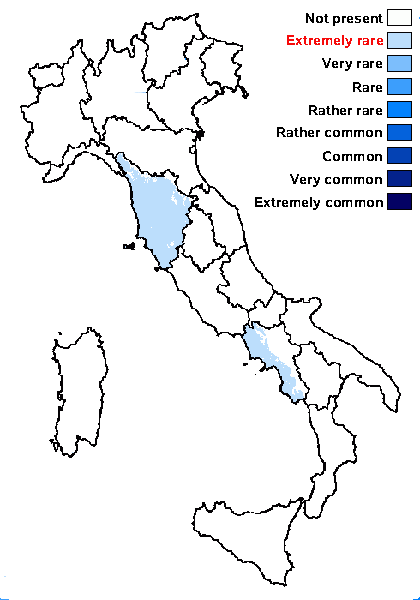Celothelium ischnobelum (Nyl.) M.B. Aguirre
Bull. Brit. Mus. Nat. Hist., Bot. ser., 21: 139, 1991. Basionym: Melanotheca ischnobela Nyl. - Flora, 59: 238, 1876.
Synonyms: Leptorhaphis carrollii A.L. Sm.; Leptorhaphis ischnobela (Nyl.) Coppins; Tomasellia ischnobela (Nyl.) Keissl.; Verrucaria myriospora Leight.
Distribution: C - Tosc. S - Camp (Puntillo & al. 2000).
Description: Thallus crustose, endosubstratic, smooth and continuous, greenish-white, pale yellow to cream-coloured, somehow shiny, sometimes delimited by a dark brown prothalline line, composed of colourless to pale brown, thin-walled, smooth, cylindrical, <4 μm thick hyphae constricted at septa, mixed with bark cells, associated with trentepohlioid algae below the surface. Perithecia black, shiny, brittle, smooth, scattered or in small clusters, circular to ellipsoid, 0.45-1 mm across, at first immersed, then projecting, hemispherical to flattened, dimidiate, the ostiole located in a small central papilla. Involucrellum blackish, brittle, covering groups of perithecia, c. 50 μm thick, composed of bark material mixed with reddish-brown, thick-walled, smooth, 2-3 μm thick hyphae, forming a clypeus of textura epidermoidea; exciple intergrading with the involucrellum, mainly differentiated at the margins of perithecia, sometimes extending below, c. 30-40(-50) μm thick, consisting of colourless to brown hyphae intermixed with bark cells forming a textura intricata; paraphysoids <2 μm thick; hymenial gel I-. Asci 8-spored, arising from the sides of the perithecium and arranged horizontally, cylindrical, bitunicate, the outer layer thin and smooth, the inner without an apparent internal apical beak, I- but with a meniscus staining I+ dark blue near the apex. Ascospores 8-many-septate, hyaline, thread-like, sometimes helically twisted in the asci, 80-110 x 1.5-2.5 μm, thin-walled. Pycnidia black, shiny, circular to elongated, smooth, at first immersed, then projecting, hemispherical-dimidiate, with a dark brown to blackish wall. Macroconidia multiseptate, thread-like, hyaline, 60-100 x 1.5-2 μm. Photobiont trentepohlioid. Spot tests: K-, C-, KC-, P-. Chemistry: without lichen substances.Note: a mild-temperate to subtropical, doubtfully lichenised species found on smooth bark, especially of Corylus and Ilex in sheltered and humid situations, with an apparently western distribution in Europe; to be looked for further in Tyrrhenian Italy. It is included in the Italian red list of epiphytic lichens as “Endangered” (Nascimbene & al. 2013c).
Growth form: Crustose
Substrata: bark
Photobiont: Trentepohlia
Reproductive strategy: mainly sexual
Most common in areas with a humid-warm climate (e.g. most of Tyrrenian Italy)
Commonnes-rarity: (info)
Alpine belt: absent
Subalpine belt: absent
Oromediterranean belt: absent
Montane belt: absent
Submediterranean belt: absent
Padanian area: absent
Humid submediterranean belt: extremely rare
Humid mediterranean belt: extremely rare
Dry mediterranean belt: absent

Predictive model
Herbarium samples
Growth form: Crustose
Substrata: bark
Photobiont: Trentepohlia
Reproductive strategy: mainly sexual
Most common in areas with a humid-warm climate (e.g. most of Tyrrenian Italy)
Commonnes-rarity: (info)
Alpine belt: absent
Subalpine belt: absent
Oromediterranean belt: absent
Montane belt: absent
Submediterranean belt: absent
Padanian area: absent
Humid submediterranean belt: extremely rare
Humid mediterranean belt: extremely rare
Dry mediterranean belt: absent

Predictive model
| Herbarium samples |
 Index Fungorum
Index Fungorum
 GBIF
GBIF


